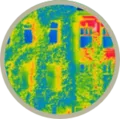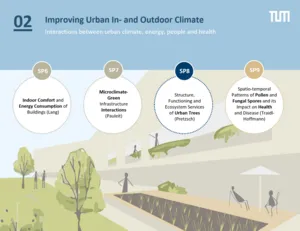Research Cluster 2: Improving Urban In- and Outdoor Climate
Head: Werner Lang
Due to the high density of buildings, the related thermal storage capacities, reduced air movement, intensity of heat sources such as buildings and cars, high degree of sealed surfaces, and lack of green areas, cities are hotter than the countryside. Because of the urban heat effect, climate change has a particularly strong impact on dense settlement structures, especially during the night, when high air and radiation temperatures have a negative influence on health and the quality of sleep of the urban population.
RC2 aims at the improvement of the urban in- and outdoor climate by
(i) assessing the causes and magnitude of the before-mentioned negative effects on human comfort and health; and
(ii) developing solutions to overcome these challenges by employing the main RTG strategies.
UGI as a substitution strategy can help to regulate the (micro)climate by providing shade, acting as windbreaks, and cooling public areas and the immediate surroundings of buildings through evapotranspiration. Furthermore, plants absorb CO2 and store carbon, while O2 is released into the atmosphere. Green unsealed areas and the soil with the deposition of pollutants can serve as a source of nutrients to UGI, as well as a water reservoir during heavy rain.
To fully understand the effects of outdoor UGI on indoor heating and cooling, and occupant’s thermal comfort, the underlying dynamics of plants and vegetation, the response patterns to different climatic and growth conditions, and the combined (dis)services of different tree species close collaboration within Cluster 2 (SP6 - Energy, SP7 - Microclimate, SP8 - Urban Trees, SP9 - Health) and with Cluster 1 (SP3 - Reconstruction, SP5 - Design) and Cluster 3 (SP10 - Drainage, SP12 - Microbiome) is required.
Cluster 2 explores the potential of the integration of UGI in inner cities to improve in- and outdoor comfort and to reduce energy consumption and the related carbon footprints in a changing climate and thereby also substitute technical systems. Mapping, modeling and prediction of UGI, including trees, hedges, lawns, roof and facade greening, will be an essential basis for the projects similar to that of Cluster 1 (SP3 - Reconstruction, SP5 - Design) and Cluster 3 (SP10 - Drainage, SP12 - Microbiome), as they all build on UGI, and aim at their structural and functional improvement. Another important aspect to address in RC2 is the operationalization of the relevant measures (substitution, integration) by analyzing the performance of the suggested strategies and the options for integration and implementation of the relevant measures into the transformation and design process. It is necessary to bridge the gap between theoretical analysis and the implementation of the developed methods in the context of complex urban planning processes. To achieve this, close collaboration within RC2 and with RC1 (SP1 - Biodiversity, SP2 - Mobility, SP4 - Governance) is required.
The subprojects of research cluster 2 are

PI: Prof. Dr.-Ing. Werner Lang
PhD candidates: Farzan Banihashemi & Roland Reitberger
Dissertation: Integrated, nature-based solutions for optimized indoor comfort in high-density urban environments.
Background: Human comfort, health and intellectual productivity are determined by indoor climate, as people spend almost 90% of their time indoors. Architectural approaches for creating comfortable indoor conditions throughout the year are not sufficiently effective in many regions. In contrast, technical means for heating, cooling, and ventilation lead to increasing CO2 emissions, and alternative solutions are urgently needed. This is particularly important for cities with disproportionally increasing temperatures and higher demand for cooling. Recent studies have shown that plants and greenery systems, such as trees, climbing plants, facade-integrated plant systems as well as green roofs have a positive effect on the micro-climate of surrounding buildings, but also on indoor thermal comfort and mental health. Thus, innovative UGI provides a methodology to couple both the technical and the biological realms for achieving optimal solutions for enhancing indoor thermal conditions while minimizing the buildings’ energy consumption and carbon emissions.
In this subproject, we will examine the potential of the substitution of technical, non-renewable systems by UGI, and functional, ecological, and technical aspects will be analyzed. Based on the results, the potential for the integration of UGI into the planning of buildings and cities will be examined in the following funding period.
The objectives are to:
(O1) Analyze the most relevant building typologies in dense inner-city environments at a neighborhood scale concerning solar exposure, outdoor comfort, air movement, and the effects on the comfort inside the buildings, setting the baseline for the following studies on integration of UGI;
(O2) Understand the options for the integration of various types of UGI into the built environment concerning their potential to moderate the outdoor climate in summer;
(O3) Investigate the effect of enhanced outdoor comfort through UGI on indoor climate;
(O4) Study the potential to reduce the energy demand and CO2 emissions for heating and cooling of buildings.
We predict that:
(H1) Building typologies in dense inner-city environments, such as point-, row- and perimeter block development, and related factors, such as density and orientation, have an immediate effect on in- and outdoor comfort and the resulting energy demand for heating and cooling;
(H2) In addition to improving outdoor comfort through architectural means, the use of UGI can improve indoor comfort and reduce CO2 emissions from the buildings;
(H3) The synergetic integration of architectural-technical and greenery systems allows for increasing the comfort conditions within buildings even in areas where trees cannot be planted, due to extended sealed surfaces in dense urban environments.
Methods: In the first stage of SP6, a systematic modeling approach will be developed that couples the analysis of outdoor micro-climates and their effect on indoor comfort at high spatial and temporal resolution. The results of the analysis of alternative scenarios will be used to maximize the effect of the integration of UGI and corresponding parameters of buildings, such as glazing quality and ratio, technical shading systems and balconies, loggias etc., thermal mass, floor plan, and options for cross-ventilation and night-time cooling of the corresponding building. To obtain a holistic view of the opportunities and potentials of such an approach, we will consider the environmental effects on the entire life cycle of the related systems, from construction, and operation to their deconstruction. The results will be used for an integrated approach to improve green-gray infrastructures. Furthermore, the opportunities for the operationalisation of the other strategies (substitution, integration) will be considered. Beyond the close collaboration within Cluster 2 with SP7, SP8 and SP9, a close collaboration is envisaged with the subprojects on urban biodiversity (SP1) and Transformative UGI (SP4) of Cluster 1 as well as with Effects of SUDS on Water Quality (SP10) of Cluster 3.
Outlook: Based on the holistic modeling approach in Funding Period I, the model and assessment method will be further developed and validated through measurements and compared to other state of art methodologies in Funding Period II. For this purpose, a case study in existing city quarters will be conducted.

PI: Prof. Dr.-Ing. Stephan Pauleit, Dr. Mohammad Rahman
Affiliated researchers: Eleonora Franceschi
PhD: Nayanesh Pattnaik
Dissertation: Interaction of urban greenspaces and surface cover in terms of urban heat and run-off reduction.
Background: There is strong evidence on urban cooling and run-off reduction via different types of UGI, with trees being mostly emphasized. Interestingly, these ESS are directly linked to the tree–water relationships, since the soil–plant–atmosphere continuum is the most critical determinant of gas exchange rates. However, understanding the dynamic relationships between ecological structure, function and ESS generated by urbangreenspaces in highly heterogeneous urban environments is yet a big challenge. The contributions of different types of vegetation and interaction between green and grey infrastructure in terms of ESS using a holistic approach is limited. The project aims towards two major impacts: improved human well-being and climate resilience, in particular, increase the quality and quantity of urban greenspaces, improvement of cooling effect, and decrease of heat stress. These impacts would be assessed using the ratio of open spaces to built-form, temperature reduction, and increased evapotranspiration through a measuring and modeling approach.
The underlying objective is to understand the interaction of different types of surface coverage with or without vegetation, their spatial heterogeneity, as well as their vegetation dynamics such as annual cycles of water use, plant growth, and phenology.
Specifically, we want to understand the effect of:
(O1) Surface coverage types on spatio-temporal variation in energy and water flux;
(O2) Plant traits determining the intensity and extension of various ESS provision;
(O3) Interaction between microclimate and surface coverage characteristics.
We postulate:
(H1) Increasing UGI will improve the thermal comfort at all spatial and temporal scales;
(H2) Trees provide higher cooling and water retention benefits compared to grass or shrubs;
(H3) The built environment with less open space has an extended effect on heat trapping.
Methods: The subproject will result in new knowledge on the functioning of multilayered urban greenspaces and outdoor climate modification intensity for current and future climate conditions. Within stage 1, sampling sites will be selected in coordination with other subprojects (SP8 - Urban Trees, SP13 - Plant Systems, SP10 - Urban Drainage Systems) to represent important open space types such as streets and squares in densely built versus low density built. Attempts will be made to include four types of coverage namely impervious surface, shrub-grass, tree-grass and tree-shrub-grass to collect both continuous and sampled field data on meteorological and edaphic variables. Mobile and permanent weather stations will be used to measure bio-meteorological variables such as radiation, wind, temperature, humidity, black globe temperature, and edaphic variables such as soil temperature and moisture. Moreover, physical properties of each surface cover type along with the structural data such as leaf area index, diameter, and height of trees shrubs, and grasses will be collected. Data will be used to estimate shading depth and area, and sensible heat fluxes. Simultaneously, transpiration of trees using TDP sap flow sensors, shrubs (porometer) and grass (lysimeter) will be measured to calculate latent heat fluxes and crop coefficients. During stage 2, functional relationships between tree growth and water balances will be investigated using leaf water potential, chlorophyll content measurements, and soil hydraulic conductivity. Total transpiration, interception water loss and infiltration rate will be used to understand water balance and runoff coefficient. In stage 3, UGI parameters such as amount of vegetation, leaf area index, composition of the vegetation, and its connectivity will be systematically varied to develop and test prototypical UGI for cooling. Modeling is intended to be linked to the subproject on Indoor Comfort and Energy Consumptions of Buildings (SP6). Additionally, interactions are expected with the research on novel plant systems (SP13).
Outlook: In Funding Period II, the findings on the functioning of multi-layered UGI and micro-climatic amelioration will be calibrated using thermal scanners and correlated with remotely sensed data. This will help development of models to assess ESS on a larger scale, not only in terms of intensity but also in terms of spatial extension.

PI: Prof. Dr. Dr. Hans Pretzsch, Prof. Dr. Thomas Rötzer
Affiliated researchers: Dr. Astrid Reischl, Martin Honold
Execution: Leila Parhizgar
Dissertation: Knowledge-based design of urban tree stock and related ecosystem service provision.
Background: Urban trees with their manifold ESS and functions offer a means for providing sustainable solutions to climate mitigation and adaptation to environmental, societal and economic challenges. By improving the knowledge about the structure, functioning, and sustainable management of urban trees this project aims at better exploitation of the potential of urban trees for climate-smart urban planning. Our overarching objective is to acquire empirical knowledge about the structure, functioning, and ESS of Urban Trees, and to integrate this knowledge in spatially explicit modeling, and sustainable management of urban tree stocks.
For this purpose, we will:
(O1) Review and model selected ESS (cooling, shading, C-sequestration, habitat provision, noise reduction) of urban trees depending on site, species and age;
(O2) Quantify urban tree mortality as essential knowledge gap for modeling and planning;
(O3) Analyze the interaction between adjacent urban trees (in situ and experiments) as this paves the way to innovative planting and arrangement designs;
(O4) Create a matrix model for sustainable planning of stocks of urban trees;
(O5) Put a special emphasis on tall and old urban trees, their growth and ESS, as old trees play an essential role for NBS and are under-represented in research so far.
The overarching hypotheses of this project are that:
(H1) ESS provision of urban trees is highly dependent on their site-conditions, creating a need for specific urban tree management plans reducing mortality and including interactions;
(H2) The potential of urban trees for climate-smart sustainable urban planning can be significantly improved by the knowledge-based design of urban tree stocks.
Methods: To meet the objectives the set of urban trees ESS will be reviewed (and to some extent measured at experimental sites in Munich), quantified and modeled depending on tree size/age, environmental conditions, competition, and facilitation. The resulting regression models may be implemented in a spatially explicit model for urban trees. Mortality will be analyzed and modeled species-specific by logistic regressions based on urban tree records of selected cities including Munich. The tree–tree interactions will be studied at mature trees in the city of Munich and also in pot experiments with common tree species and species assemblages. Further, we will develop a spatially explicit model for sustainable management of urban trees, analogously to the concept of sustainable forestry developed by von Carlowitz. The main drivers of the model will be species-specific tree diameter growth functions and mortality rates. By auxiliary relations, ESS such as biomass, carbon stock, or cooling can be estimated. A given state of an urban tree stock can be assessed by a set of sustainability indicators regarding its distance from a target stock. As old and tall trees provide large portions and unique aspects to ESS and as they were somehow under-represented by urban tree research so far, we will pay attention to them by our empirical and model work. The empirical and the modeling part of this project will cover the following indicators at the individual tree level but also (by modeling and up-scaling) at the quarter level: Indicators for human well-being (in cooperation with SP9 and SP12), climate smartness in terms of mitigation and adaptation (SP2, SP5, and SP6), water regulation (SP10 and SP13), pollution reduction (SP7 and SP9), and habitat and biodiversity provision (SP1).
Outlook:
Period I will yield a model prototype for spatial explicit modeling and analyzing urban tree structure, functioning, and ESS. Based on this, we will further develop, validate, and apply this model for multicriteria scenario analysis for assessment, planning, and sustainable management of urban tree stocks in Period II.

PI: Prof. Dr. Claudia Traidl-Hoffmann (Universität Augsburg)
Affiliated researchers: Dr. Maria Pilar P. García, Caroline Holzmann
PhD Candidate: Carolin Trost
Dissertation: A spatially and temporally high-resolution three-dimensional database of the meteorological structure and dynamics and the associated aeroallergen distribution and its relation with heat and disease in patients and healthy controls.
Background: Allergies are the most common chronic disease in Germany and Europe. Particularly in the younger population, allergies are widespread at more than 30% and lead to significant losses in the quality of life of those affected and their families. Socio-economic damage through a reduced performance at school, college, and work is the result. The significant increase in atopic diseases over the past five decades is most likely a by-product of our modern lifestyle, which is characterized by increasing urbanization and changing dietary habits. However, as numerous results from our research group suggest, the allergenicity of plant pollen could also be influenced by climate change factors, in particular drought stress and increased atmospheric CO2 concentration.
These connections justify the need for a special level of transdisciplinary research, which will be possible within the framework of this graduate school.
This subproject aims to:
(O1) Determine the effects of climate change and urbanization on allergy-relevant ecosystems, urban living conditions, and finally on health and diseases;
(O2) Investigate the impact of climate change on shifts in the reproductive seasons and habitats of allergenic plants. We will check whether an increase of vegetation cover in urban areas has disadvantages in terms of pollen and spore load, and thus on health and disease.
The overarching hypotheses of this project are that:
(H1) There is high variety of spatiotemporal patterns within cities;
(H2) Many other meteorological factors impact of spatiotemporal patterns of pollen and fungal spores in cities;
(H3) Development and application of digital twin technology within a Panel study investigating pollen exposure and Reactome will unravel personal symptom thresholds;
(H4) Correlations between microscale urban climate effects and pollen and fungal spore loads can be used as decision-making aids in urban planning.
Methods: To measure pollen and fungal spores in cities we will refine a sensor for bioaerosols to lay the foundation for the development of a digital twin technology. Besides, the bioaerosols will be combined with other environmental, supplemented, and jointly integrated into digital products for early warning systems. Mobile pollen traps (measuring pollen and spores) will be located in different in- and outdoor locations. To investigate pollen and spore occurrence in different heights in differing urban areas unmanned aerial vehicles (UAV’s) will be used. The focus is on the sources, transport pathways, and sinks, which are highly relevant for health care and urban planning. Based on this, health and allergy-relevant or health-endangering weather conditions are identified and meteorologically characterized. Spatially differentiated patterns of climatic parameters and thermal of climatic parameters, thermal and aeroallergenic exposure in urban areas will be determined. In the next step, pollen and fungal spore exposure will be correlated to patients’ symptom data.
This data will be available within a panel-study of 50 allergics that are filling in daily symptoms paralleled by regular lab visits. This panel-study is constantly running in Augsburg since 2016. Thus, we will investigate how the thermal climate of UGI influences air quality. The benefit is, on the one hand, that established correlations between micro-scale urban climate effects and pollen and fungal spore loads can be used as decision-making aids in urban planning. On the other hand, projections of future climate change scenarios can be used to assess the climate change scenarios provide an assessment of long-term planning relevance. This project will significantly add to a benefit of people at risk of allergies: a short-term reaction planning of stays in risk zones as well as in an improved assessment of the allergy risk by treating physicians. Pollen is also known to adsorb and accumulate pollutants from stormwater run-off like heavy metals and organic substances and can significantly influence the behavior of Sustainable drainage systems (SUDS).
Outlook: In Period I, a spatial and temporal mapping of the meteorological structure and dynamics together with the aeroallergen distribution will be established. This will be the basis for the Period II, in which these data will be used to set up an APP-based early warning system for allergics. The goal is a personalized and tailored prevention of allergic diseases.
